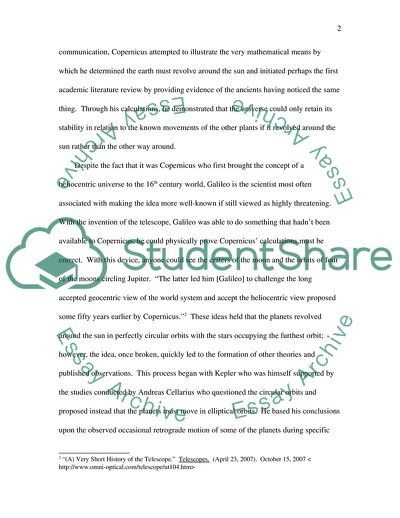
- Home
- Free Samples
- Premium Essays
- Editing Services
- Extra Tools
- Essay Writing Help
- About Us
- Studentshare
- Subjects
- Miscellaneous
- History
History - Essay Example

- Subject: Miscellaneous
- Type: Essay
- Level: Masters
- Pages: 4 (1000 words)
- Downloads: 0
- Author: robertolynch
Extract of sample "History"
Concepts such as a new understanding of the universe and the use of a new invention like the telescope to prove it led to other new forms of investigation such as the dissection, developing processes that ensured the Scientific Revolution would continue to affect society today. Beginning the often contentious and sometimes life-threatening dialogue that would eventually change the world, Copernicus realized the magnitude of his ideas. He sought support from Pope Paul III regarding his soon-to-be published and revolutionary idea that the earth revolved around the sun rather than the other way around.
1 In his communication, Copernicus attempted to illustrate the very mathematical means by which he determined the earth must revolve around the sun and initiated perhaps the first academic literature review by providing evidence of the ancients having noticed the same thing. Through his calculations, he demonstrated that the universe could only retain its stability in relation to the known movements of the other plants if it revolved around the sun rather than the other way around. Despite the fact that it was Copernicus who first brought the concept of a heliocentric universe to the 16th century world, Galileo is the scientist most often associated with making the idea more well-known if still viewed as highly threatening.
With the invention of the telescope, Galileo was able to do something that hadn’t been available to Copernicus, he could physically prove Copernicus’ calculations must be correct. With this device, anyone could see the craters of the moon and the orbits of four of the moons circling Jupiter. “The latter led him [Galileo] to challenge the long accepted geocentric view of the world system and accept the heliocentric view proposed some fifty years earlier by Copernicus.”2 These ideas held that the planets revolved around the sun in perfectly circular orbits with the stars
...Download file to see next pages Read MoreCHECK THESE SAMPLES OF History
History - United States History 1865
Patients History
Latin American history (Chicano history)
Aboriginal history
Colonial history US History
World history and american history
World history and american history
Native American History: Shawnee History

- TERMS & CONDITIONS
- PRIVACY POLICY
- COOKIES POLICY